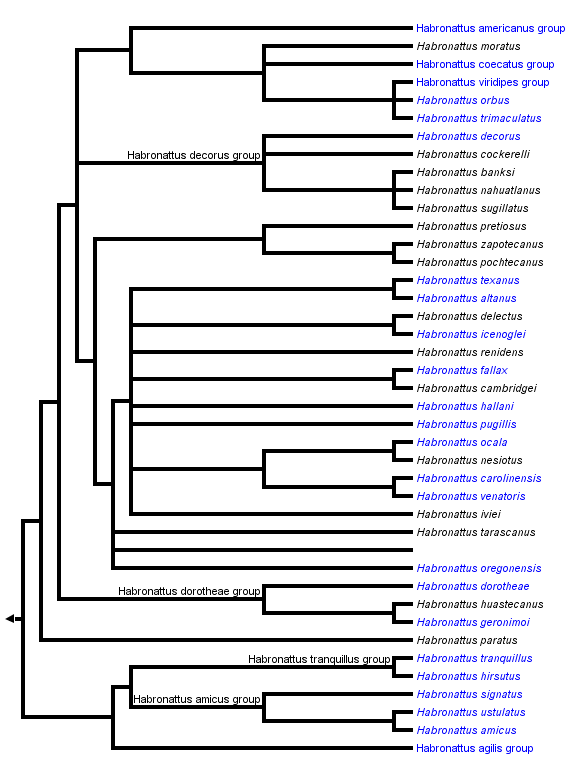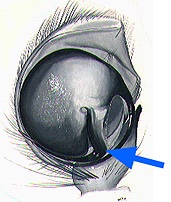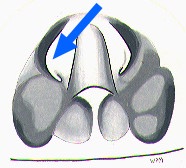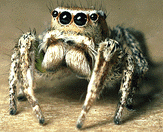Habronattus
Wayne MaddisonA large and diverse genus of medium-sized New World salticids, primarily ground-dwellers with highly ornamented males that perform complex courtship displays. The elbowed tegular apophysis of the palp is distinctive. The third leg is much longer than the fourth, distinguishing these from other superficially similar salticids such as Sitticus.



This tree diagram shows the relationships between several groups of organisms.
The root of the current tree connects the organisms featured in this tree to their containing group and the rest of the Tree of Life. The basal branching point in the tree represents the ancestor of the other groups in the tree. This ancestor diversified over time into several descendent subgroups, which are represented as internal nodes and terminal taxa to the right.

You can click on the root to travel down the Tree of Life all the way to the root of all Life, and you can click on the names of descendent subgroups to travel up the Tree of Life all the way to individual species.
For more information on ToL tree formatting, please see Interpreting the Tree or Classification. To learn more about phylogenetic trees, please visit our Phylogenetic Biology pages.
close boxTree from Griswold (1987), figures 10, 12-16. Some described species are excluded from this tree, namely species known only from females, some of which may be synonyms of species shown.
Introduction
Habronattus includes approximately 100 species of jumping spiders, most from North America, the remainder in the neotropics. Most are ground-dwelling on open ground with sparse vegetation, especially on rocks, dry leaf litter and sand. The arid southwest has many species, but Florida also has many species, and others are known above the Arctic circle and east to maritime Canada. The genus was recently revised by Griswold (1987), and its phylogeny studied by Maddison and Hedin (2003).
The genus is notable for the remarkable forms and colors of the coursthip ornaments of males, which are used in complex courtship behaviors.
Characteristics
Habronattus is relatively well-delimited as monophyletic by:
- a unique elbow on the tegular apophysis of the male palpus (A)
- the form and position of the openings of the female epigynum (B)
- the male third legs being longer than the first (Griswold, 1987).

 A
A  B
B A. Male palpus. B. Female epigynum. © Wayne Maddison.
Of these, the most distinctive is the elbowed tegular apophysis. Some species in the coecatus group have secondarily lost the elbow, but their possession of the distinctively modified third legs marks them as members of the genus Habronattus.
Discussion of Phylogenetic Relationships
The tree shown above is that of Griswold (1987), derived by Hennigian cladistic analysis on morphological characters primarily related to male courtship ornamentation and genitalia. Major clades in Habronattus include a group of 32 described species whose males have laterally fringed first legs, spatulate spines on the first leg, and a modified third leg. This clade includes the coecatus species group and the viridipes group. The americanus group is another clear clade, delimited by peculiar genitalia and male courtship ornaments. The agilis group has a unique stridulatory organ (Maddison and Stratton, 1988).
Though some aspects of this tree are strongly supported, others are likely to change as more data come in. For instance, there is little support for the large clade from H. pretiosus to H. hirsutus. One species included by me in Habronattus but not by Griswold is H. paratus, which has the elbowed tegular apophysis characteristic of the genus even though the first legs are unusually long and the female's epigynum appears to retain a somewhat primitive arrangement. Habronattus paratus may be the sister species to the rest of the genus.
References
Griswold, C. E. 1977. Biosystematics of Habronattus in California. M.Sc. Thesis, University of California, Berkeley.
Griswold, C. E. 1979. New species of Pellenes from California (Araneae: Salticidae). J. Arachnol. 7:129-138.
Griswold, C. E. 1987. A revision of the jumping spider genus Habronattus F.O.P.-Cambridge (Araneae; Salticidae), with phenetic and cladistic analyses. University of California Publications, Entomology 107: 1-344.
Maddison, W. P. 1982. XXXY sex chromosomes in males of the jumping spider genus Pellenes (Araneae: Salticidae). Chromosoma (Berlin), 85:23-37.
Maddison, W. P. and G. E. Stratton. 1988. Sound production and associated morphology in male jumping spiders of the Habronattus agilis species group (Araneae: Salticidae). J. Arachnology 16: 199-211.
Peckham, G. W. and E. G. Peckham. 1889. Observations on sexual selection in spiders of the family Attidae. Occ. Pap. Wisconsin Nat. Hist. Soc. 1:3-60.
Peckham, G. W. and E. G. Peckham. 1890. Additional observations on sexual selection in spiders of the family Attidae, with some remarks on Mr. Wallace's theory of sexual ornamentation. Occ. Pap. Wisconsin Nat. Hist. Soc. 1(3): 117-151.
Peckham, G. W. and E. G. Peckham. 1901. Spiders of the Phidippus group of the family Attidae. Trans. Wisconsin Acad. Sci., Arts and Letters 13: 282-359.
Peckham, G. W. and E. G. Peckham. 1909. Revision of the Attidae of North America. Trans. Wisconsin Acad. Sci., Arts and Letters 16: 355-646.
Richman, D. B. 1977. Comparative studies on the mating behavior and morphology of some species of Pellenes (Araneae - Salticidae). MSc thesis, University of Arizona.
Richman, D. B. 1982 . Epigamic display in jumping spiders (Araneae, Salticidae) and its use in systematics. J. Arachnol. 10:47-67.
Information on the Internet
Proszynski's Catalogue entry for HabronattusTitle Illustrations

| Scientific Name | Habronattus |
|---|---|
| Specimen Condition | Live Specimen |
| Copyright |
© 1994-1995 Wayne Maddison

|
About This Page
Wayne Maddison

University of British Columbia, Vancouver, British Columbia, Canada
Correspondence regarding this page should be directed to Wayne Maddison at
Page copyright © 1995 Wayne Maddison
All Rights Reserved.
Citing this page:
Maddison, Wayne. 1995. Habronattus. Version 01 January 1995 (under construction). http://tolweb.org/Habronattus/3069/1995.01.01 in The Tree of Life Web Project, http://tolweb.org/







 Go to quick links
Go to quick search
Go to navigation for this section of the ToL site
Go to detailed links for the ToL site
Go to quick links
Go to quick search
Go to navigation for this section of the ToL site
Go to detailed links for the ToL site